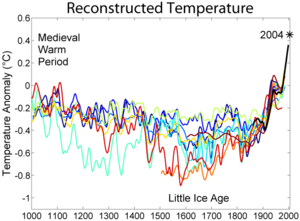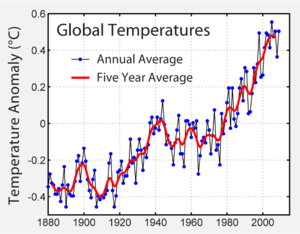
Temperature record of the past 1000 years
Background to the schools Wikipedia
SOS Children made this Wikipedia selection alongside other schools resources. Click here to find out about child sponsorship.
The temperature record of the past 1,000 years describes the reconstruction of temperature for the last 1000 years on the Northern Hemisphere. A reconstruction is needed because a reliable surface temperature record exists only since about 1850. Studying past climate is of interest for scientists in order to improve the understanding of current climate variability and, relatedly, providing a better basis for future climate projections. In particular, if the nature and magnitude of natural climate variability can be established, scientists will be better positioned to identify and quantify human generated climate variability (commonly referred to as 'anthropogenic global warming' (AGW)). Although temperature reconstructions from proxy data help us understand the character of natural climate variability, attribution of recent climate change relies on a broad range of methodologies of which the proxy reconstructions are only a small part .
According to all major temperature reconstructions published in peer-reviewed journals (see graph), the increase in temperature in the 20th century and the temperature in the late 20th century is the highest in the record. Attention has tended to focus on the early work of Mann, Bradley and Hughes (1998), whose "hockey stick" graph was featured in the 2001 United Nations Intergovernmental Panel on Climate Change report. The methodology and data sets used in creating the Mann et al. (1998) version of the hockey stick graph are disputed, most notably by Stephen McIntyre and Ross McKitrick.
For general information about temperature records see the main article: Temperature record. For information on the description of the Medieval Warm Period and Little Ice Age in various reports see the main article: MWP and LIA in IPCC reports
General techniques
By far the best observed period is from 1850 to the present day. Over this period the recent instrumental record, mainly based on direct thermometer readings, has approximately global coverage. It shows a general warming in global temperatures.
Quantitative methods using proxy data
As there are few instrumental records before 1850 temperatures before then must be reconstructed based on proxy methods. One such method, based on principles of dendrochronology, uses the width and other characteristics of tree rings to infer temperature. The isotopic composition of snow, corals, and stalactites can also be used to infer temperature. Other techniques which have been used include examining records of the time of crop harvests, the treeline in various locations, and other historical records to make inferences about the temperature. These proxy reconstructions are indirect inferences of temperature and thus tend to have greater uncertainty than instrumental data.
In general, the recent history of the proxy records is calibrated against local temperature records to estimate the relationship between temperature and the proxy. The longer history of the proxy is then used to reconstruct temperature from earlier periods. Proxy records must be averaged in some fashion if a global or hemispheric record is desired. Considerable care must be taken in the averaging process; for example, if a certain region has a large number of tree ring records, a simple average of all the data would strongly over-weight that region. Hence data-reduction techniques such as principal components analysis are used to combine some of these regional records before they are globally combined.
An important distinction is between so-called 'multi-proxy' reconstructions, which attempt to obtain a global temperature reconstructions by using multiple proxy records distributed over the globe and more regional reconstructions. Usually, the various proxy records are combined arithmetically, in some weighted average. More recently, Osborn and Briffa used a simpler technique, counting the proportion of records that are positive, negative or neutral in any time period . This produces a result in general agreement with the conventional multi-proxy studies.
Several reconstructions suggest there was minimal variability in temperatures prior to the past century (see, for example, ). More recently, Mann and Jones have extended their reconstructions to cover the last 2000 years (GRL, 2003 ). The work was reproduced by Wahl and Ammann in 2005 .
The Mann, Bradley and Hughes (1998) version of the temperature record is known as the "Hockey Stick" graph, first coined by Jerry Mahlman, a colleague of Mann's.
The work of Mann et al., Jones et al., Briffa and others forms a major part of the IPCC's conclusion that "the rate and magnitude of global or hemispheric surface 20th century warming is likely to have been the largest of the millennium, with the 1990s and 1998 likely to have been the warmest decade and year" .
Qualitative reconstruction using historical records
It is also possible to use historical data such as times of grape harvests, sea-ice-free periods in harbours and diary entries of frost or heatwaves to produce indications of when it was warm or cold in particular regions. These records are harder to calibrate, are often only available sparsely through time, may be available only from developed regions, and are unlikely to come with good error estimates. These historical observations of the same time period show periods of both warming and cooling.
Astrophysicist Sallie Balunias notes that these temperature variations correlate with solar activity and asserts that the number of observed sunspots give us a rough measure of how bright the sun is. Balunias and others have suggested that periods of decreased solar radiation are responsible for historically recorded periods of cooling such as the Maunder Minimum and the Little Ice Age. The same argument would imply that periods of increased solar radiation contributed to the Medieval Warm Period, when Greenland's icy coastal areas thawed enough to permit farming and colonization.
Limitations
The apparent differences between the quantitative and qualitative approaches are not fully reconciled. The reconstructions mentioned above rely on various assumptions to generate their results. If these assumptions do not hold, the reconstructions would be unreliable. For quantitative reconstructions, the most fundamental assumptions are that proxy records vary with temperature and that non-temperature factors do not confound the results. In the historical records temperature fluctuations may be regional rather than hemispheric in scale.
In a letter to Nature (August 10, 2006) Bradley, Hughes and Mann pointed at the original title of their 1998 article: Northern Hemisphere temperatures during the past millennium: inferences, uncertainties, and limitations (Geophys. Res. Lett. 26, 759–762; 1999) and pointed out more widespread high-resolution data are needed before more confident conclusions can be reached and that the uncertainties were the point of the article. The press release for the 1998 article framed the uncertainty in terms of regional impacts.
The "Hockey stick controversy"
There is an ongoing debate about the details of the temperature record and the means of its reconstruction, centered on the Mann, Bradley and Hughes (1998), "hockey stick" graph. Stephen McIntyre and Ross McKitrick claimed various errors in the methodology of Mann et al. (1998) and that the MBH method when tested on persistent red noise, nearly always produces a hockey stick shaped first principal component. In turn, Mann (supported by Tim Osborn, Keith Briffa and Phil Jones of the Climatic Research Unit) has disputed the claims made by McIntyre and McKitrick . The IPCC AR4 says that M&M may have some theoretical foundation, but Wahl and Ammann (2006) also show that the impact on the amplitude of the final reconstruction is very small .


